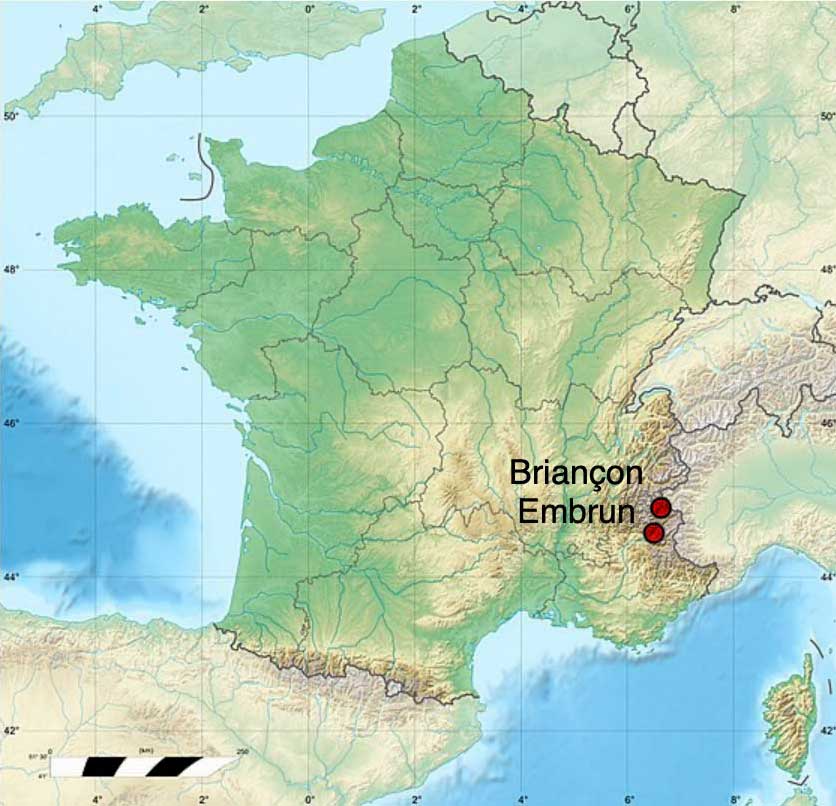that kind of tree, which you see among the mountains of Briançon and Ambrun,
Original French: celle eſpece d’arbre que voyez par les montaignes de Briançon, & Ambrun,
Modern French: celle espèce d’arbre que voyez par les montaignes de Briançon, & Ambrun,
Some relationship to Piémont, a recurring allusion in these chapters.
Notes
Briançon and Embrun
tree in the mountains of Briançon and Ambrun
Agaricum potum obolis tribus in vini veteris cyatho uno lieni medetur, e panace omnium generum radix in mulso, sed teucria praecipue pota arida et decocta quantum manus capiat in aceti heminis tribus ad heminam. inlinitur eadem ex aceto aut, si tolerari non possit, ex fico vel aqua. polemonia bibitur ex vino, vettonica drachma in oxymelitis cyathis tribus, aristolochia ut contra serpentes. argemonia septem diebus in cibo sumpta lienem consumere dicitur, agaricum in aceto mulso obolis duobus. nymphaeae heracliae radix in vino pota et ipsa consumit. cissanthemus drachma bis die sumpta in vini albi cyathis duobus per dies xl lienem dicitur paulatim emittere per urinam. prodest et hysopum cum fico decoctum, lonchitidis radix decocta priusquam semen demittat, peucedani quoque radix et lieni et renibus. lien suco acori poto consumitur—praecordiis et ilibus utilissimae radices—clymeni semen potum diebus xxx pondere denarii in vino albo, vettonicae farina ex melle et aceto scillite pota, radix lonchitidis in aqua. teucrium inlinitur, item scordium cum cera, agaricum cum farina e feno Graeco.
Agaric taken in drink, the dose being three oboli in one cyathus of old wine, is good for disorders of the spleen, as is the root in honey wine of all kinds of panaces, but best of all is teucria, dried and taken in drink by boiling down to one hemina a handful of it with three heminae of vinegar. In vinegar it is also used as a liniment, or, if that cannot be borne, in figs or water. Polemonia is taken in wine, or a drachma of betony in three cyathi of oxymel, or aristolochia as used for snake bite. Argemonia, taken in food on seven consecutive days, is said to reduce the spleen, and so are two oboli of agaric in oxymel. It is reduced also by the root of nymphaea heraclia taken in wine or by itself. Cissanthemus, if a drachma is taken twice daily in two cyathi of white wine for forty days, is said to carry off the spleen gradually in the urine. Useful too is a decoction of hyssop with fig, or of the root of lonchitis before it sheds its seed, while a decoction of root of peucedanum is good for both spleen and kidneys. The spleen is reduced by the juice of acoron taken by the mouth—the roots are very useful for trouble of the hypochondria and groin—by the seed of clymenus taken in drink for thirty days, the dose being a denarius by weight in white wine, by powdered betony taken in honey and squill vinegar, and by root of lonchitis in water. Teucrium is used as liniment, likewise scordium with wax, or agaric with powdered fenugreek.
peony
Vetustissima inventu paeonia est, nomenque auctoris retinet, quam quidam pentorobon appellant, alii glycysidem. nam haec quoque difficultas est quod eadem aliter alibi nuncupatur. nascitur opacis montibus caule inter folia digitorum quattuor ferente in cacumine veluti Graecas nuces quattuor aut quinque. inest his semen copiosum, rubrum nigrumque. haec medetur et Faunorum in quiete ludibriis. praecipiunt eruere noctu, quoniam si picus Martius videat tuendo in oculos impetum faciat.
The first plant to be discovered was the peony,The peony. which still retains the name of the discoverer; it is called by some pentorobon, by others glycyside, for an added difficulty in botany is the variety of names given to the same plant in different districts. It grows on shaded mountains, having a stem among the leaves about four fingers high, which bears on its top four or five growths like almonds, in them being a large amount of seed, red and black. This plant also prevents the mocking delusions that the Fauns bring on us in our sleep. They recommend us to uproot it at night-time, because the woodpecker of Mars, should he see the act, will attack the eyes in its defence [volando will mean “by flying at them”; eruentem,“the person uprooting it”].
Melze
Meleses estants si frequentes au territoire d’Embrum & autout de Morienne, ne donneront despense à recouurer. Elles ont leurs semences plus petites que Cyprés, tant en la pommette que au noyau, toutesfois chasque chartée sur le lieu, qui l’entreprendoit, ne cousteroit pas un sou. C’est sur celuy dont la Manne est cueillie, & la grosse Terebenthine & l’Agaric aussi, & dont l’arbre est autant frequent es montaignes des Grisons, nommez en Latin Theti, qu’il fut onc, & es mesmes endroicts dont Tibere Empereur en feit apporter à Rome pour refaire le pont Naumachiarius, qui auoit esté bruslé.
Briançon and Ambrun
Fortresses in Dauphiné.
Ambrun
Embrun, ch.-l. arr. Hautes-Alpes. Rabelais fit probablement l’exploration botanique de cette région lorsqu’il était attaché à Guillaume de Bellay, gouverneur du Piémont. Cf. Heulhard, Rabelais… ses voyages en Italie, p. 116-117.
kind of tree in the mountains of Briançon and Ambrun
Cf. Pline, XXV, 9; XXVI, 48. Pour l’érudition de tout ce paragraphe, consulter S. Champier, Gallicum pentapharmacum, Rhabarbo, Manna, Terebinthina, et Sene Gallicis, constans, Lyon, 1534.
